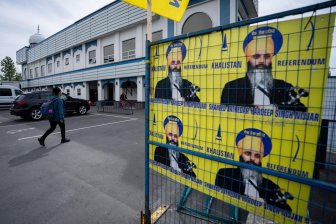A German researcher believes a mislabelled grave may be the reason a Canadian Lancaster bomber crew has been missing for more than 75 years.

The tombstone in the German village of Auerstedt states, “an unknown American soldier killed in March 1945,” but researcher René Schütz believes local villagers actually buried Canadian airmen, and he says he has the evidence to prove it.
Schütz is with Vermisstensuche Thüringen, a group that searches for missing airmen from the Second World War. Its members have spent the last year looking at the story of the Auerstedt grave.
“It was clear from the beginning it wasn’t an American,” Schütz says.
The region around Auerstedt was an important target for allied Bomber Command during the war. Dozens of missions were sent out to hit oil refineries important to the Nazi war effort.
According to local legend, an allied bomber crashed outside the village in March 1945, but before it went down, one member of the crew jumped out. He died when his parachute didn’t open. The rest of the crew was still in the plane when it hit the ground, and the bombs it was carrying exploded.
Schütz says he spoke to eyewitnesses who are still alive. They reported that local villagers buried the body of the crewman who jumped from the plane, but also buried the human remains they found at the crash site.
“They gathered all the remains from the debris field,” Schütz says. “They buried those with the remains of the complete airman.”
Schütz says there are remnants of the aircraft still at the crash site outside town that prove the aircraft was a Lancaster bomber — a plane the American military didn’t fly.
After looking at the type of aircraft, the location of the crash, and the date it went down, Schütz believes the plane and the crew were, in fact, Canadian.
Schütz’s group took their findings to local authorities and were given permission to exhume the grave on March 13. He says they found exactly what they expected.
“The complete remains of one dead man were found, along with a small coffin that contained the remains of an undetermined number of dead,” Schütz says.
Those remains were handed over to the German War Graves Commission for analysis.
The Commonwealth Graves Commission confirms it’s working with German officials and has notified Canada.
“The Canadian authorities are aware of the case, but it is far too early to speculate as to the nature or nationality of the recovered remains,” the commission said in a statement to Global News.
A spokesperson with Canada’s Department of National Defence says it’s holding off until German officials officially link the remains to Canada. If that happens, the Canadian Armed Forces’ Casualty Identification Program would review the case. The process could take several years.
One thing Schütz hopes can speed up the process is something recovered in the grave. Canadian soldiers wore identity discs during the two world wars — basically an early version of military dog tags.
When exhuming the grave, the team recovered what appears to be a fragment of a disc with three letters, CAN. Schütz says that was an abbreviation used for Canada, and proves his theory is correct.
“It was very emotional for our whole team,” he says.
Schütz believes he knows which aircraft crew he’s found. He’s chosen not to make that public for now. But there is only one plane missing without a trace that was on a bombing mission in that region of Germany in mid-March 1945.
Canadian military historian David O’Keefe says it’s still early in the process, but Schütz’s discovery could be important.
“If all the evidence is there, and it does conclusively prove that this was the aircraft, this is huge,” O’Keefe says. “Not just for Canada and Canadians, but also the families.”
- ‘Summer of discontent’ coming over public service in-office order: unions
- N.S. couple felt they won ‘doctor lottery’ after years on wait-list. Now they’re back on it
- Family says infant killed in 401 crash leaves a ‘void that can never be filled’
- More than half of parents report burnout, U.S. study finds. What can be done?








Comments